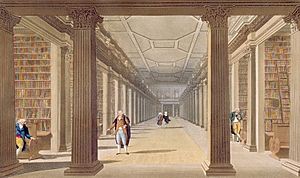George Miller (historian) facts for kids
George Miller (born 1764 – died 6 October 1848) was an Irish Anglican priest and historian. He taught at Trinity College, Dublin. He is famous for creating a course on modern European history. He started this course after he was not chosen for a professor job. Instead, he became an assistant to Francis Hodgkinson, who was the history professor but never gave lectures. Miller's college lectures were published in parts between 1816 and 1828. Later, they were put into four books in 1832. The book was called History, philosophically illustrated, from the fall of the Roman Empire, to the French Revolution. It was printed three times.
Contents
Early Life and Education
George Miller was born in 1764. He studied at Trinity College, Dublin. He earned three degrees from the college. One of his degrees was a Doctor of Divinity (DD).
Academic Career and History Lectures
Miller became a fellow at Trinity College, Dublin, in 1789. A fellow is like a senior member of the college staff. In 1790, he joined the Royal Irish Academy. This is a group that promotes learning and research. He later served on its Council and as a secretary.
In 1799, he hoped to become a professor of Natural and Experimental Philosophy. But Thomas Elrington got the job instead. As a kind of special award, Miller was made an assistant to Francis Hodgkinson. Hodgkinson was the new professor of modern history. However, Professor Hodgkinson did not give any lectures on history for 41 years!
John Kearney, who was in charge of the college, suggested an idea to Miller. Kearney's brother had written popular lectures about the government of Rome. He thought Miller could do something similar for modern history. So, Miller started a series of lectures on modern European history. At first, only a few smart students came. But slowly, more and more students joined. Soon, the lectures became so popular that they had to be held in the large Examination Hall.
Miller said his lectures "slowly and gradually formed." He also said they were not based on strong religious feelings. However, others later described his lectures as very religious. In his book, Miller explained how he connected difficult historical facts with his religious beliefs. He believed that everything in history, good or bad, helped to improve human society. He thought that even leaders who did bad things were, without knowing it, part of a bigger plan from a wise and kind God.
This idea is called the Providential tradition. It means believing that God guides all events. A magazine called The Dublin University Magazine wrote in 1839 that Miller showed "God reigneth in the affairs of men." It also said that God's goal was to make people better. Another magazine, The Edinburgh Review, wrote in 1830 that Miller believed all world events were connected. They thought he showed that studying history helps us understand God's perfection.
In 1799, Miller wrote a letter to Lord Castlereagh. Castlereagh was an important government official in Ireland. Miller had heard rumors that a new college might be built in Armagh. In his letter, Miller shared his ideas about what the college should teach. He also compared universities in England, Scotland, and Ireland. He found things he liked and disliked about all of them. The college was never built, and Castlereagh did not reply. But Miller's letter shows his wide-ranging ideas about education. It also tells us about how universities taught students back then.
In 1804, Miller left his teaching job at Trinity College. He became a priest in County Fermanagh. But he kept giving his history lectures until 1811. He earned £100 a year for them. After he stopped, history lectures also stopped at Trinity College for a while. His lectures were first published as Lecturers on the philosophy of modern history between 1816 and 1828. They were later reissued in four books in 1832. This new edition was called History, philosophically illustrated, from the fall of the Roman Empire, to the French Revolution. It was printed three times.
Clerical Career
In 1804, George Miller became a priest in Derryvollan, County Fermanagh. Later, he became a senior priest in Armagh. He also became the headmaster of a school there.
Death and Legacy
George Miller died on 6 October 1848. He was married to Elizabeth Ball. Her father was Robert Ball from County Wicklow. Miller had several children. His son, Stearne Ball Miller, became a well-known politician and judge. Another son, Charles, became a priest in Carlingford, County Louth. His daughter was named Emily. Miller's grandson, Beaver Henry Blacker, also became an Irish Anglican priest and historian.
Selected Publications
- History, philosophically illustrated, from the fall of the Roman Empire, to the French Revolution. London, 1832. (This was his most famous work, published in four volumes.)



